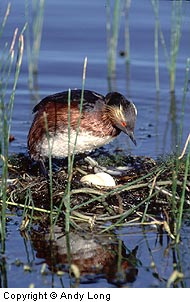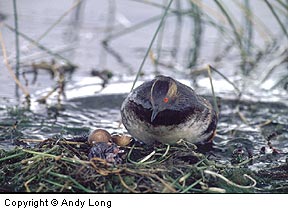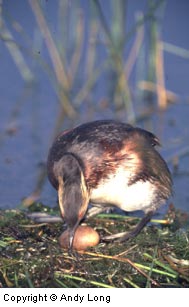 Memories of a special event live with you forever.Photographs help preserve those memories intact.As photographers, we witness many different special moments, but everyone has one that stands out from the others.This is the one I’ll never forget:
Memories of a special event live with you forever.Photographs help preserve those memories intact.As photographers, we witness many different special moments, but everyone has one that stands out from the others.This is the one I’ll never forget:
Living in Colorado, I have numerous places I like to go to do photography, depending on the time of year.One of these is Arapahoe National Wildlife Refuge, located in the North Park region five miles south of Walden.The refuge contains a series of ponds, home to many types of waterfowl during the summer nesting season.
On a late June trip with several other photographers, I came across a pond populated with about a dozen eared grebes. Since Arapahoe is a drive-through refuge, we were able to photograph the birds from our vehicles. As we watched their movements, we noticed that they had built nests, and several birds were sitting on eggs. Eventually, we were able to set up next to the road.As long as we didn’t make quick movements, our presence didn’t seem to bother the nesting birds. (In a drive-through refuge, the birds get used to people. Some will let you work with them without taking flight.)
If we had caused the grebes to stay off the eggs, we would have moved on. However, this wasn’t the case, so we stayed.Not knowing how long the eggs had been there, we had no idea what to expect. Magically, while we were there, the female on the nest closest to us laid an egg. My friend who saw it described how the bird stood up on the nest, did a little shake, and then exerted some energy.When we looked in the nest again, there was an additional, near-white egg.The other eggs in the nests were brown. The excitement of the experience only whetted my appetite. Later, when I was able to do research, I found it takes between twenty and twenty-two days for eared grebe eggs to hatch.I marked my calendar for three weeks hence and started planning a return trip.
The Saturday morning I had marked on my calendar, I had to lead a workshop, but as soon as it was over, I packed my car and was ready to leave for the Arapahoe National Wildlife Refuge. Throughout the two- and- a- half hour drive, I kept hoping I wouldn’t be too late. By the time I arrived, it was mid-afternoon, and the sun was at a bad angle, but I hurried to check the nest out. I was delighted to observe two eggs still in the eared grebe nest closest to my car. Within a short while, a newborn grebe appeared and crawled up on its fathers back and under its wing. This behavior is normal for grebes and numerous other waterfowl that fly infrequently, have small broods, wide bodies, and slow-maturing young.During diving, the young clamp their bills over their parents’ feathers.
Even though the conditions weren’t perfect, I took some shots of the newborn eared grebe. One egg still lay on the nest, which typically consists of a floating platform made of fresh and decaying vegetation anchored to existing vegetation–usually in shallow water containing reeds. I planned to stay until the egg hatched.I just hoped it wouldn’t hatch during the night.
The second egg didn’t hatch that evening, so I planned to return the next morning around sunrise to wait for the hatching.That morning, the egg still sat on the nest.As the clock ticked and the hours wore on, several photographers came and left for whatever reason.Two of us decided to stay. Our plan was to sit there all day. Not much could deter us from seeing the hatching, as long as there was daylight.Our willingness to stay was put to the test late in the morning as storm clouds built to the west over the mountains.We could see the rain and lightening in the distance. They were moving our way.
We decided to wait.In less than ideal conditions, our persistence paid off.At 12:25 p.m., the female eared grebe got off the nest. We noticed a small hole in the egg.No matter what the weather had in store, we were determined to stay. After the first hole in the egg, the parents were off the nest more than they were on it.They kept coming to the nest to check the progress of their soon-to-be newborn. My friend and I worried whether we might be the cause.
Breaking out of an egg is not an easy process for a chick.The shell has to be strong enough during incubation for the adults to sit on it without breaking.Nature provides two tools to help the chicksbreak out.One is an egg tooth and the other is powerful hatching muscles on the back of their heads and necks. Even with these, birds have been known to take up to six days to hatch after breaking the first hole.
 Ten minutes after the chick poked the first hole in the shell, a second hole appeared a short distance from the first.A couple of minutes later, the chick punched a hole between the two pinholes. Then progress slowed. Thirty-five minutes passed before the chick created a fourth hole about the size of a pencil eraser.More holes and rips appeared until, finally, the newborn eared grebe hatched an hour-and-a-half after making the first hole.
Ten minutes after the chick poked the first hole in the shell, a second hole appeared a short distance from the first.A couple of minutes later, the chick punched a hole between the two pinholes. Then progress slowed. Thirty-five minutes passed before the chick created a fourth hole about the size of a pencil eraser.More holes and rips appeared until, finally, the newborn eared grebe hatched an hour-and-a-half after making the first hole.
Throughout all of this, the other grebes in the area stayed away from the nest area.Every once in a while, the mother would sit on the egg, but she wouldn’t stay there long.Fifteen minutes after the hatching, the mother took the broken shell in its beak, dove under the water, and deposited the shell a short distance from the nest. While this was happening, the storm inched closer. However, even with lightening dancing all around and raindrops falling, nothing was going keep my friend and I from enjoying the experience.
Obviously, the unwritten law that you shoot only during the prime light a couple of hours after sunrise and before sunset isn’t written in stone.Wildlife don’t know the rules and will do things, such as hatching, at other times.Even when the light isn’t perfect, if you keep shooting, you’ll end up with the pictures you want.
After depositing the shell, the female grebe continued climbing back on the nest waiting for the hatchling to climb on her back.Unlike the night before when I saw the chick climb on its fathers back in no time at all, this newborn seemed to be having some problems.Most of the trouble seemed to originate with its mother.Whereas the father positioned itself nicely for the baby to make its way up on his back, the female kept stepping on this chick, not giving it an opportunity to climb up on her back.Fifteen minutes after the egg was deposited and just over two hours after the chick made the first hole in its egg, the baby grebe made its way up onto its mothers back to begin a new life.
 Riding on the backs of their parents serves a twofold purpose for eared grebe chicks.Besides protecting them from predators, the position allows them an easy way to eat some of the parent’s feathers.This is done because the gizzard in fish-eaters doesn’t sufficiently crush bones as they’re swallowed. The parental feathers in the stomach, which are formed into balls, protect the thin stomach wall from being punctured by sharp bones. They also slow digestive process, so bones dissolve rather than pass into the intestine.
Riding on the backs of their parents serves a twofold purpose for eared grebe chicks.Besides protecting them from predators, the position allows them an easy way to eat some of the parent’s feathers.This is done because the gizzard in fish-eaters doesn’t sufficiently crush bones as they’re swallowed. The parental feathers in the stomach, which are formed into balls, protect the thin stomach wall from being punctured by sharp bones. They also slow digestive process, so bones dissolve rather than pass into the intestine.
When the newborn eared grebe finally made it up on its mothers back, I felt compelled to stand up and applaud. I wanted to give a big thank you to one of the best shows I’ve ever seen.Even if I hadn’t been a photographer or if the weather conditions had become so bad that I couldn’t continue shooting, I would’ve been filled with enough joy to justify every minute I spent watching the nest.
To take full advantage of opportunities like watching birds hatching, knowing about your subject beforehand is as important as knowing the equipment you use. (This is true whether you’re watching waterfowl or any other wildlife.) Even though you’re able to get closer to birds nesting in frequented areas, you need to take precautions.No matter where a bird places a nest, there are almost certainly predators in the area.Keep an eye out both in the air and on the ground.If you see predators, leave so you don’t bring attention to the eggs or newborn.
Another consideration you must make when you’re working birds on the nest is to avoid keeping the adults off during incubation.Grebe eggs are one type that don’t need constant incubation.Soon after they’re deposited, the eggs need incubation, but as time goes on, the necessary incubation time decreases because the embryo is capable of generating its own heat as it develops.You’ll noticethe adults turning the eggs.This helps warm the eggs more evenly and prevents the embryonic membranes from sticking to the shell.
When photographing eared grebes, pay attentionto their color.They’re very dark with gold ear tufts, a bright red eye and a white under-belly.During nesting, it’s best to get your reading from the nest since they’re composed of both fresh and decaying vegetation.This will give you the best exposures. As in all wildlife photography, making sure the eye is in focus is paramount when photographing eared grebes.The bright red eyes with a black dot in the middle make this easy. With the gold tufts along the side of its head, the eared grebe can be a very memorable bird to photograph.
By Andy Long

Leave a Reply